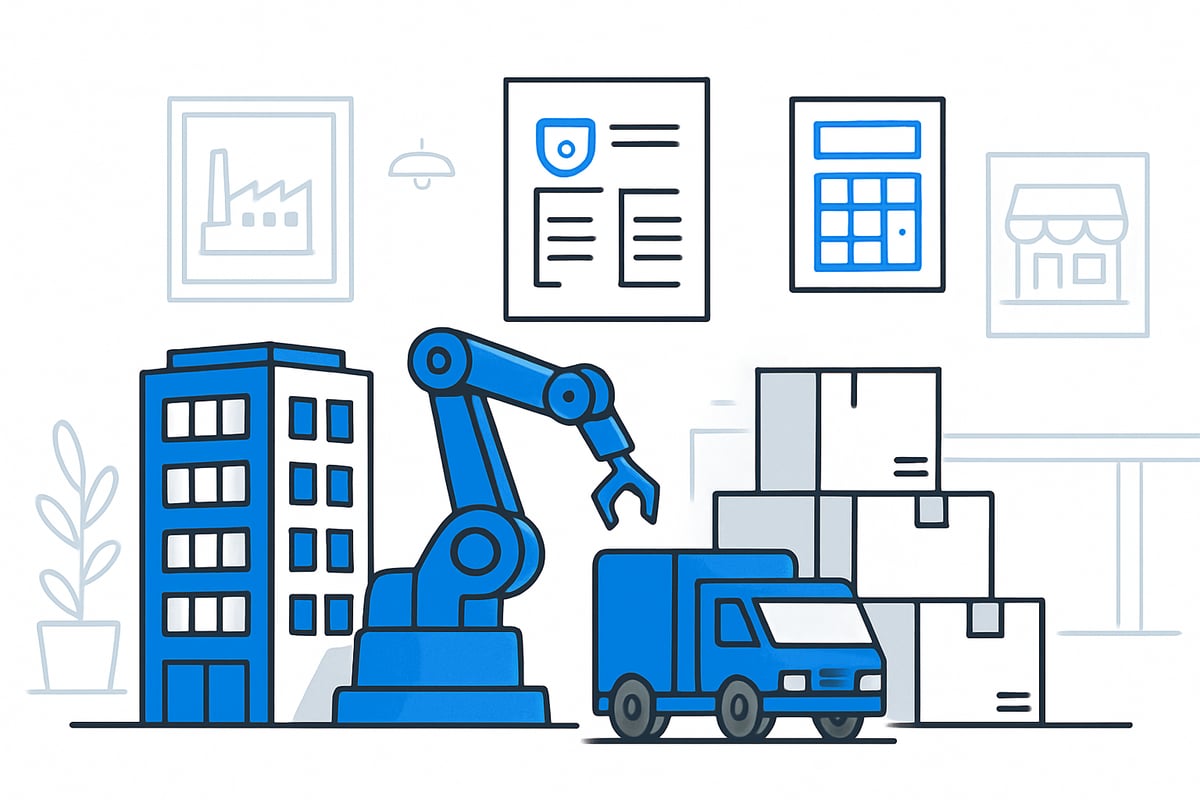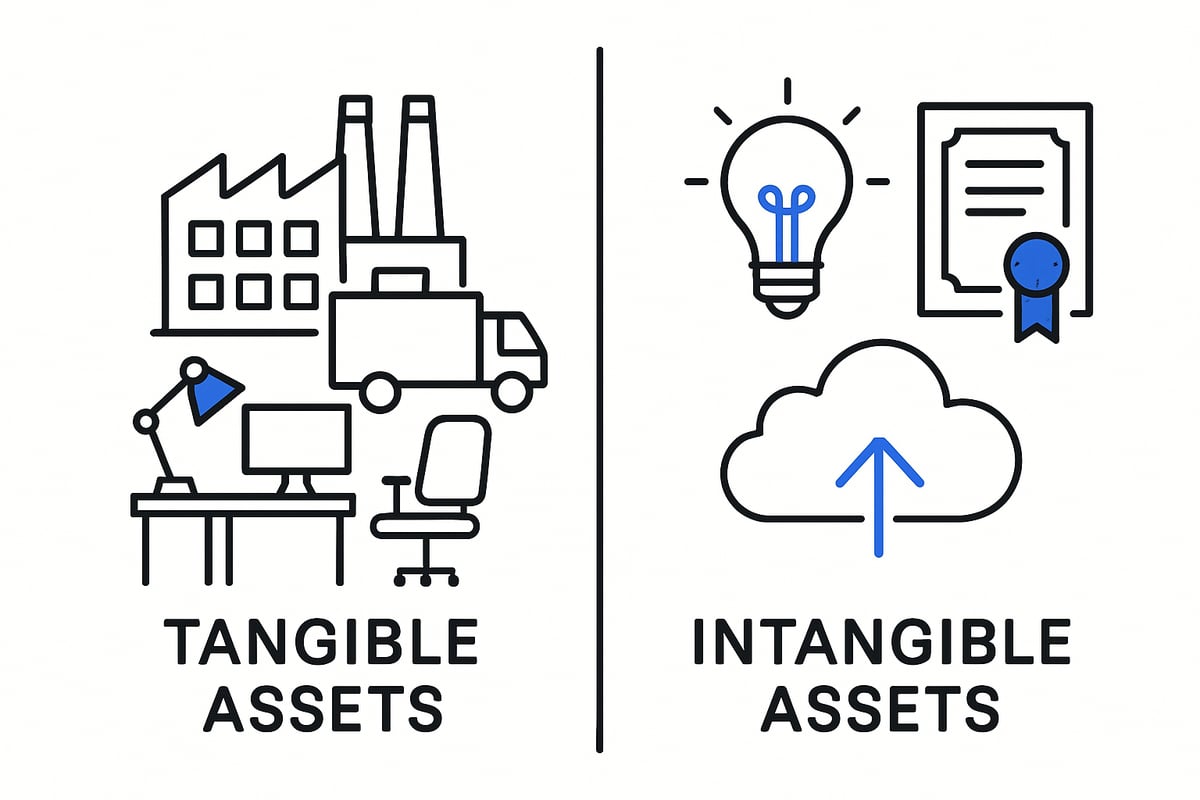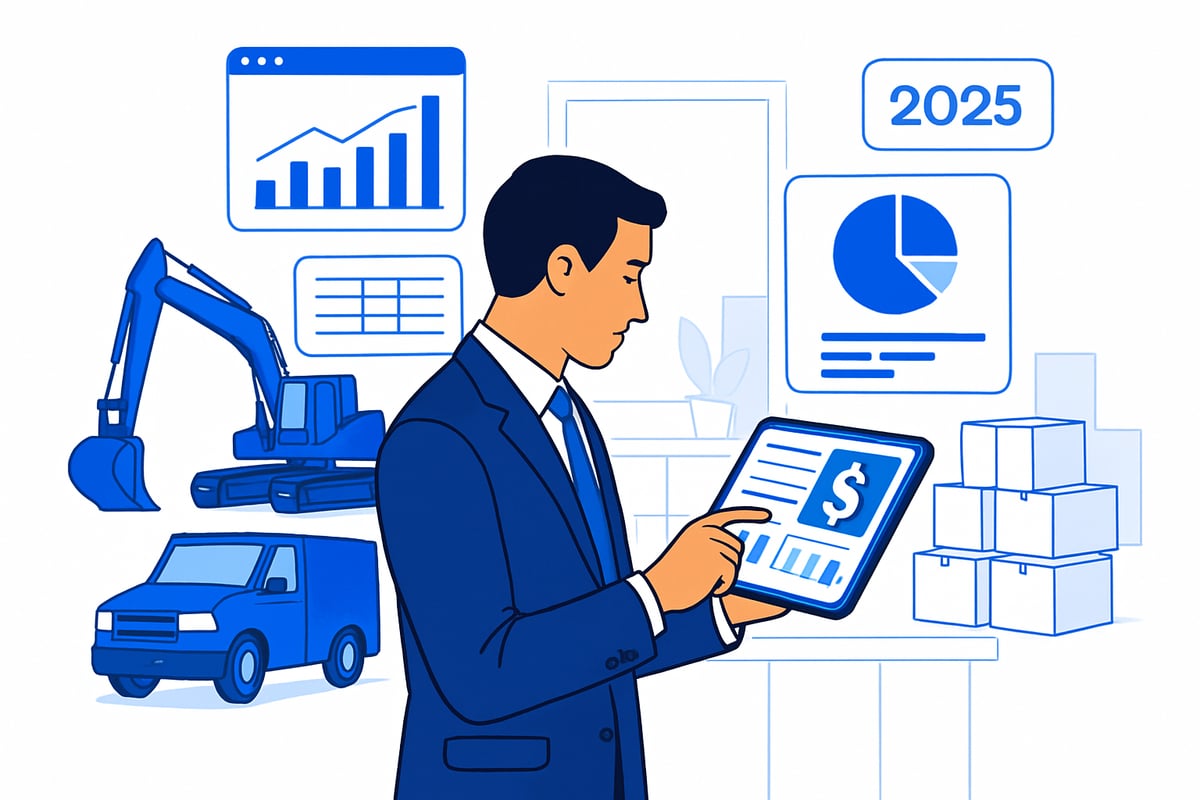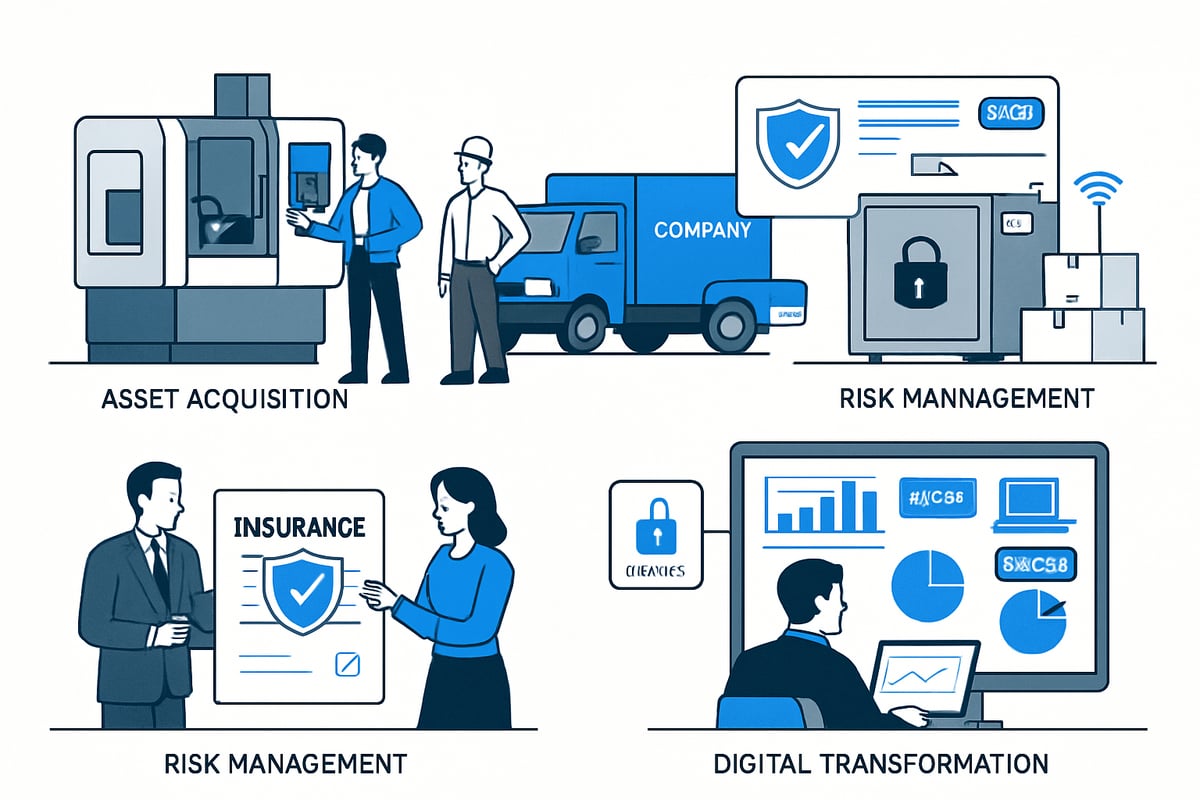Tangible Asset Guide: Understanding Value in 2025
In 2025, the question of what truly creates business value is more urgent than ever. At the center of this discussion lies the tangible asset, a cornerstone for companies navigating today’s changing landscape.
This guide aims to demystify the tangible asset, explain its evolving role, and offer practical steps for maximizing its worth in the modern economy. Whether you are a business owner, investor, or finance professional, you will gain clear insights into valuation, management, and upcoming trends.
Join us as we define what tangible assets are, compare them to intangibles, explore valuation methods, and share best practices for protecting and leveraging real-world value in your industry.
What Are Tangible Assets?
Understanding the concept of a tangible asset is essential for anyone involved in business, finance, or investment. A tangible asset is any physical, measurable resource owned by a company that holds monetary value. These assets are crucial for supporting daily operations, driving long-term growth, and providing collateral for financing.

Definition and Core Concepts
A tangible asset is defined as a physical item a business owns that can be measured and valued. Unlike intangible assets, which lack physical substance and include things like patents or brand reputation, tangible assets are concrete and visible. The distinction is crucial: while both contribute to a company's value, only a tangible asset can be touched or seen.
In accounting, a tangible asset appears on the balance sheet as part of a company’s total assets. These are typically classified as either current assets, such as inventory, or long-term assets, like property, plant, and equipment (PP&E). For example, land, buildings, machinery, vehicles, and office equipment are all considered tangible assets.
It’s important to note that not everything physical is a tangible asset in accounting terms. For instance, cash is categorized as a financial asset rather than a tangible asset on the balance sheet. This distinction often leads to confusion, so understanding the correct classification is vital for accurate reporting.
Tangible assets play a fundamental role in business operations. They enable production, facilitate service delivery, and support administrative functions. In sectors like manufacturing and real estate, tangible assets represent a significant share of total business assets. According to BDC, these assets account for a majority of the asset base in such industries.
For readers seeking further clarity on financial terminology, the Financial terms glossary offers comprehensive definitions to support your understanding.
A table can help illustrate common tangible asset examples:
| Asset Type | Examples |
|---|---|
| Land/Buildings | Office buildings, warehouses |
| Machinery | Production equipment, tools |
| Vehicles | Delivery trucks, company cars |
| Inventory | Raw materials, finished goods |
| Office Equipment | Computers, furniture |
Types of Tangible Assets
Tangible assets are categorized based on their function and expected lifespan. Inventory, for example, includes raw materials, work-in-progress, and finished goods. These are current assets, typically used or sold within a year.
Fixed assets, also known as property, plant, and equipment (PP&E), form the backbone of many businesses. These include land, buildings, machinery, and large-scale equipment. Leasehold improvements—modifications made to rented property—are also classified as tangible assets if they enhance the value and utility of the space.
Specialized categories such as vehicles, rolling stock, and computer equipment are essential in sectors like logistics, transportation, and technology. The mix of tangible assets varies by industry. For instance, a tech company may own primarily computer equipment, while a manufacturer will have a high concentration of machinery and inventory.
Lifecycle and depreciation are important considerations for every tangible asset. Most fixed assets depreciate over time, reflecting wear and tear or technological obsolescence. For example, a manufacturing company’s tangible asset breakdown might show 50% in machinery, 30% in buildings, and 20% in vehicles and inventory. This mix impacts both operational efficiency and financial performance.
Understanding the structure and management of each tangible asset type is critical for optimizing value and ensuring long-term business success.
Tangible vs. Intangible Assets: Key Differences and Strategic Roles
Understanding the distinction between tangible asset categories and their intangible counterparts is essential for sound financial strategy. These two classes of assets shape how businesses build value, make investments, and report results.

Core Differences
A tangible asset is a physical and measurable resource that a business owns. These assets have a real-world presence, such as land, buildings, machinery, vehicles, and inventory. By contrast, intangible assets are non-physical and include things like patents, trademarks, copyrights, and goodwill.
The primary difference lies in physical substance. A tangible asset can be touched and seen, while an intangible asset exists only as a legal right or intellectual property. This distinction affects how each is valued and managed.
Accounting practices also set these assets apart. Tangible assets are recorded on the balance sheet under property, plant, and equipment or as inventory. Their value is typically determined using market prices or historical cost, minus depreciation. Intangible assets, however, are often harder to value and may not appear on the balance sheet unless acquired externally.
Depreciation applies to tangible asset types, reducing their book value over time due to wear and tear. Intangibles are amortized or tested for impairment, reflecting changes in their economic benefit.
Here's a quick comparison:
| Feature | Tangible Asset | Intangible Asset |
|---|---|---|
| Physical Presence | Yes | No |
| Examples | Buildings, vehicles, inventory | Patents, trademarks, goodwill |
| Balance Sheet | Listed | Sometimes listed |
| Valuation | Market comparables, cost approach | Complex models, often subjective |
| Accounting Treatment | Depreciation | Amortization, impairment |
Many believe cash is a tangible asset, but in strict accounting, it's classified as a financial asset rather than a tangible asset.
Strategic Importance in 2025
In 2025, the role of each asset type is rapidly evolving. The rise of technology and digital services means intangible assets now represent a larger share of corporate value, especially among leading tech firms. Yet, the tangible asset remains critical in sectors like manufacturing, logistics, and real estate.
The interplay between tangible asset investments and intangible growth drivers can create business resilience. For example, a logistics company relies on its fleet and warehouses (tangible asset base), but also benefits from proprietary software (intangible asset) to optimize operations.
Recent data shows that, as of 2024, S&P 500 companies saw intangible assets surpass tangible asset values on their balance sheets. However, in fields like industrials and real estate, tangible asset holdings still drive core business value.
Consider a real estate firm, where land and buildings dominate the asset structure. Compare this to a SaaS provider, which holds minimal tangible asset value but significant intellectual property and software licenses.
Global trends further highlight this shift. According to the World Intangible Investment Highlights 2025, intangible asset investments have surged worldwide, but companies must balance these with sound management of tangible asset holdings to ensure long-term stability.
Regulatory and reporting standards continue to adapt, requiring precise disclosure and valuation of both asset types. Understanding these distinctions allows businesses to make informed decisions, allocate resources wisely, and remain competitive as value drivers shift in the modern economy.
How to Value Tangible Assets in 2025
Valuing a tangible asset accurately is critical for businesses navigating the complexities of 2025. With economic shifts, technological change, and regulatory updates, understanding the true worth of physical resources ensures sound decision-making and financial stability.
Whether you are a business owner, investor, or finance professional, mastering tangible asset valuation is the cornerstone of reliable reporting, tax optimization, and strategic planning.

Valuation Methods and Best Practices
Choosing the right method to value a tangible asset depends on the asset type, industry, and business objectives. In 2025, three primary approaches dominate:
| Method | Description | Best For |
|---|---|---|
| Cost Approach | Historical cost minus depreciation | Machinery, equipment |
| Market Approach | Comparing similar assets in active markets | Real estate, vehicles |
| Income Approach | Projecting future cash flows generated | Specialized assets, rentals |
The cost approach remains widely used for assets where replacement costs are predictable. For instance, a factory machine's value is calculated by subtracting accumulated depreciation from its purchase price.
The market approach is ideal when comparable sales exist. Real estate and vehicles benefit from this method, as their fair value is often shaped by recent transactions.
The income approach is best for assets generating direct revenue. Here, you estimate future cash flows and discount them to present value.
Selecting the right method matters, as it impacts financial ratios and business leverage. For instance, understanding tangible asset value can directly influence your company's debt-to-equity ratio, a key metric for lenders and investors.
In 2025, inflation, supply chain volatility, and rapid technological change all affect how tangible asset values shift. Regular reviews and market benchmarking are now essential for reliable asset reporting.
Depreciation, Amortization, and Impairment
Once a tangible asset is recorded, its value changes over time due to use, aging, or market factors. Depreciation is the systematic reduction in value, reflecting wear and tear.
Two common depreciation methods are:
- Straight-line: Equal expense each year over the asset’s useful life.
- Declining balance: Higher expense in early years, decreasing over time.
For example, a delivery truck may depreciate faster in its initial years, impacting both book value and tax deductions.
Amortization applies to leasehold improvements and similar assets, spreading costs over their useful life. Impairment testing is also crucial. If a tangible asset’s market value drops below its book value, an impairment loss must be recognized.
In 2025, updates to standards like IFRS and GAAP require more frequent impairment reviews, especially in volatile markets. Accurate depreciation and impairment schedules protect against overstated assets and ensure compliance.
Average useful life varies by asset class. For example, machinery may last 10–15 years, while office equipment is often replaced within 5–7 years. Regularly updating these schedules is critical for precise reporting.
Documentation and Audit Trail
Proper documentation underpins every tangible asset valuation. Maintaining an up-to-date asset register ensures each asset is tracked from acquisition to disposal.
Key best practices include:
- Recording acquisition details, serial numbers, and location
- Updating maintenance and repair logs
- Documenting depreciation, amortization, and impairment entries
Technology is transforming asset management. Tools like RFID tags and IoT sensors enable real-time tracking, reducing errors and supporting audit readiness.
A robust audit trail not only simplifies annual audits but also enhances internal controls. In 2025, digital asset management platforms are increasingly vital for businesses aiming to safeguard their tangible asset data and maintain regulatory compliance.
By prioritizing accurate records and leveraging technology, companies can maximize the value, security, and longevity of every tangible asset on their books.
Managing and Optimizing Tangible Assets for Business Value
Effectively managing tangible asset value is crucial for business growth and resilience. Today, organizations must approach every stage of the asset lifecycle with precision and proactive strategies. From acquisition to disposal, risk mitigation, and digital tools, optimizing each tangible asset ensures maximum return and long-term sustainability.

Asset Lifecycle Management
The tangible asset lifecycle covers four key stages: acquisition, utilization, maintenance, and disposal. Each phase demands its own set of best practices to protect and enhance value.
Acquisition begins with careful due diligence. Analyze requirements, assess supplier reliability, and explore financing options. Strategic procurement reduces costs and aligns investments with business goals.
Utilization focuses on maximizing asset productivity. Assign assets to appropriate functions, monitor performance, and ensure resources are not underused. For example, a logistics company can streamline operations by tracking vehicle usage and reallocating underutilized trucks.
Maintenance is vital for preserving tangible asset value. Implement preventive maintenance schedules, which often cost less than emergency repairs. Regular inspections and timely servicing extend asset life and reduce downtime.
Disposal decisions should be strategic. Evaluate whether to resell, recycle, or write off assets at the end of their useful life. Planning for asset replacement or upgrades can benefit from financial tools like a sinking fund, which helps set aside resources for future asset needs.
Lifecycle management also means documenting every stage. Maintain accurate records for compliance, audits, and informed decision-making. Smart lifecycle management ensures every tangible asset delivers optimal value throughout its existence.
Risk Management and Protection
Protecting tangible asset value requires a multi-layered risk management approach. Begin with comprehensive insurance coverage. Assess the types and levels of insurance needed for each asset class, from property and equipment to inventory and vehicles. Stay informed about the claims process to avoid gaps in protection.
Physical security is another priority. Install surveillance, access controls, and secure storage for high-value assets. For connected assets, invest in robust cybersecurity to guard against digital threats.
Disaster recovery planning is essential. Develop business continuity plans that address natural disasters, theft, or system failures. For example, after a hurricane, a manufacturing firm with backup power and offsite data storage can recover tangible asset operations faster.
Regulatory compliance is non-negotiable. Stay up to date with environmental, safety, and reporting standards specific to your industry. Failure to comply can result in financial penalties and loss of asset value.
By proactively identifying risks and implementing controls, companies safeguard tangible asset investments and ensure business continuity.
Technology and Digital Transformation
Digital transformation is redefining tangible asset management. Modern businesses use asset management software to track assets in real time, manage maintenance schedules, and generate compliance reports with ease.
The Internet of Things (IoT) is revolutionizing asset monitoring. Smart sensors attached to equipment provide instant data on condition, usage, and location. This enables predictive maintenance, which prevents costly breakdowns by addressing issues before they escalate.
Digital twins, or virtual replicas of tangible asset portfolios, allow businesses to simulate scenarios and optimize performance. Advanced data analytics uncover trends in asset utilization, helping leaders make evidence-based decisions.
For instance, a manufacturing plant leveraging AI and IoT can predict machinery failures, schedule timely repairs, and reduce downtime. This not only protects the tangible asset but also drives operational efficiency.
Embracing technology enhances transparency, reduces costs, and maximizes the value of every tangible asset in your organization.
Industry-Specific Considerations for Tangible Assets in 2025
Navigating the landscape of tangible asset management in 2025 means understanding how different industries approach, value, and safeguard their physical resources. Each sector faces unique challenges and opportunities, shaped by its reliance on various asset types, regulatory standards, and economic pressures.
Sectoral Trends and Requirements
The composition and management of tangible asset portfolios vary widely by industry. In manufacturing, tangible asset investments often focus on machinery, production lines, and inventory. Real estate firms prioritize property holdings and infrastructure, while logistics companies depend on fleets, warehouses, and transportation networks.
Retailers must optimize inventory and store fixtures, balancing rapid turnover with efficient asset tracking. Agriculture’s tangible asset base includes land, specialized equipment, and biological assets such as crops and livestock. Meanwhile, tech and service sectors usually maintain a lower tangible asset ratio, concentrating on critical infrastructure like servers and office equipment.
Consider the following table summarizing tangible asset percentages by industry:
| Industry | % Tangible Assets (Est.) |
|---|---|
| Manufacturing | 60–80% |
| Real Estate | 80–90% |
| Logistics | 65–75% |
| Retail | 50–70% |
| Agriculture | 70–85% |
| Tech/Service | 10–30% |
Inventory plays a significant role in liquidity analysis, especially for sectors like retail and manufacturing, as explained in Quick ratio explained. Understanding these nuances helps businesses allocate resources effectively and enhance their tangible asset value.
Regulatory and Environmental Factors
Evolving regulations and sustainability standards are reshaping the tangible asset landscape. Many industries now face strict reporting and compliance requirements, such as environmental impact disclosures and safety standards.
Green building certifications have become a major consideration in real estate, directly influencing a tangible asset’s market value and appeal. Manufacturing and logistics must comply with emissions regulations and workplace safety rules, adding complexity to asset management. Industry-specific tax incentives, like accelerated depreciation for energy-efficient equipment, further influence asset strategy.
Environmental, Social, and Governance (ESG) factors are especially impactful. For example, real estate companies achieving top ESG ratings often see higher occupancy rates and property values. This shift means businesses must evaluate tangible asset investments not just for immediate utility, but for long-term resilience and regulatory alignment.
Global and Economic Influences
Global events and economic conditions continue to affect tangible asset values and management strategies. Supply chain disruptions, as seen in recent years, can delay asset acquisition or increase costs, especially for sectors dependent on imported machinery or components.
Geopolitical risks, such as trade restrictions and political instability, may threaten asset security and prompt businesses to diversify their tangible asset base across regions. Inflation and fluctuating interest rates impact asset financing and valuation, making strategic planning essential.
In 2025, organizations that regularly reassess tangible asset values, monitor external risks, and adjust their asset portfolios are better positioned to weather uncertainty and seize new opportunities.
Future Trends: The Evolving Role of Tangible Assets
Rapid change is redefining how organizations view their tangible asset portfolios. As we approach 2025, business leaders must pay close attention to new trends shaping the value, management, and strategic importance of these physical resources.
Shifting Value Drivers in the Modern Economy
The definition and role of the tangible asset are evolving. Digital transformation is driving a convergence of physical and virtual value. Smart factories now use IoT sensors and digital twins to manage every tangible asset in real time. This integration increases productivity and extends asset lifespan.
Automation and robotics are rising as key tangible asset investments. Businesses leverage automated equipment to boost efficiency and reduce manual labor. Meanwhile, sustainability is influencing asset design, with companies opting for equipment and facilities built for durability and reuse.
The asset-light business model is gaining traction, especially in sectors like logistics and retail. Firms rent or share tangible asset resources instead of owning them outright, freeing up capital for innovation. Globalization further complicates tangible asset management, requiring leaders to navigate cross-border regulations and diverse market risks.
Consider renewable energy projects. Here, tangible asset investments in wind turbines, solar panels, and infrastructure are critical for long-term returns. Companies must balance innovation and regulatory compliance while maximizing asset performance.
For a deeper dive into how tangible and intangible assets interact to drive modern productivity, review Getting tangible about intangibles: The future of growth and productivity?. This analysis highlights why a holistic approach to value creation is essential.
Preparing for 2025 and Beyond
To future-proof their organizations, leaders should focus on strategic tangible asset allocation. Scenario planning is vital. By modeling different economic, technological, and regulatory futures, businesses can adapt their tangible asset strategies for resilience and growth.
Talent is another key factor. Asset management now demands expertise in digital tools, data analytics, and sustainability standards. Upskilling teams ensures that tangible asset value is maximized throughout the lifecycle.
Projected growth rates for tangible asset investment vary by sector. Manufacturing, infrastructure, and renewable energy are expected to lead, responding to global demand and government incentives. Meanwhile, service and technology sectors will continue to rely on critical infrastructure assets, even as their intangible holdings expand.
Embracing data-driven decision-making is crucial. Real-time asset tracking, predictive maintenance, and advanced analytics help organizations optimize every tangible asset for performance and compliance. By staying agile and informed, businesses can turn physical resources into sustainable competitive advantages.
The evolving role of the tangible asset in 2025 calls for strategic vision, adaptability, and a commitment to innovation. Those who master these trends will be well positioned for the future.
Frequently Asked Questions About Tangible Assets
Navigating tangible asset questions is essential for business owners and investors in 2025. Here are answers to the most common queries about tangible asset management and value.
What qualifies as a tangible asset in 2025?
A tangible asset is a physical, measurable resource a business owns and uses to generate value. Examples include land, equipment, buildings, vehicles, and inventory. These assets are recorded on the balance sheet and have a clear, physical presence.
How do businesses decide between investing in tangible vs. intangible assets?
Businesses assess industry needs, growth strategy, and risk tolerance when choosing between asset types. In capital-intensive sectors, tangible asset investments are crucial, while tech and service firms may prioritize intangible assets. To learn more about intangible value, see Intangible Assets: The New Currency Of Business Success.
What are the tax implications of owning tangible assets?
Tangible asset owners can typically claim depreciation, reducing taxable income over the asset’s useful life. Tax rules vary by region and asset type, so consult a tax professional for guidance.
How often should tangible assets be revalued?
Revaluation schedules depend on the asset type, market volatility, and regulatory requirements. Many businesses review tangible asset values annually, especially for high-value or rapidly depreciating items.
What are common mistakes in managing tangible assets?
Common errors include lack of proper documentation, neglecting maintenance, poor tracking, and failing to update asset values. These mistakes can lead to financial misstatements or missed opportunities.
How do global trends impact tangible asset value?
Global trends like inflation, supply chain disruptions, and regulatory shifts can affect tangible asset value. Monitoring these factors helps businesses protect and optimize their tangible asset portfolio in changing markets.
Where can I find more resources or professional advice?
For tailored advice on tangible asset valuation and management, consult certified accountants, industry associations, or financial advisors. Many organizations publish guides and best practices for asset owners.
As you’ve seen, understanding tangible assets—and knowing how to value, protect, and optimize them—will be vital for success in 2025 and beyond. If you’re eager to go deeper and explore how history can illuminate today’s financial markets, we invite you to join us in building a platform where learning from the past is just as important as planning for the future. Your insights and feedback could help shape a truly unique experience for investors, professionals, and curious minds alike. Ready to make your mark? Join our beta and help us bring history to life.
